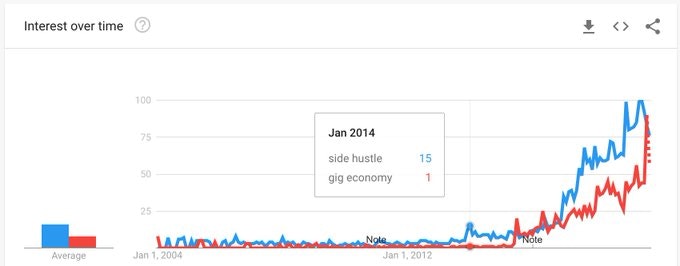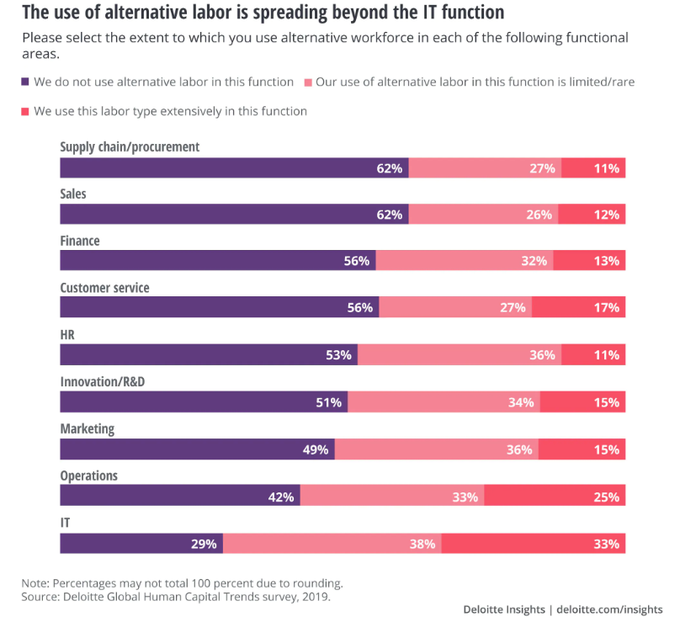For the last month, I’ve been tweeting a daily tidbit of gig economy trivia on the @artofgig twitter account, and I’ll be compiling them here every couple of weeks here as a newsletter issue, as I was doing with the tips before.
Interestingly, these trivia items get far fewer likes and retweets than the tips. I think we all recognize the importance of staying on top of gig economy trends, but it’s not nearly as much fun as the fortune cookie stuff. Still you gotta eat your spinach. I plan to keep this series going for a hundred tweets as well. For this series, contributions are welcome. Tweet good trivia items at me (this compilation should give you a sense of what I consider “good”) and I’ll feature them in the tweet series.
Here are trivia items 1-22
Gig Economy Trivia #1: In 1780, less than 20% of the US workforce had paycheck jobs (Source: Images of Organization by Gareth Morgan)
Gig Economy Trivia #2: The smallest firm size range tracked by the BLS (Bureau of Labor Statistics) is 1-4, which means solopreneurs and free agents are basically not tracked.
Gig Economy Trivia #3: According to the BLS, in the US, employment share of firms with 1-4 employees fell from 5.59 to 4.75% between 1993 and 2018. In the same period, the share of firms with over 10,000 employees rose from 35.69% to 40.39%
Gig Economy Trivia #4: Unemployment is measured with respect to workforce participation rate, and does not count those who have given up looking. This rate has fallen from around 67% in 2000 to around 63% today. link.
Gig Economy Trivia #5: In the US, over 80% of the workforce was in paycheck employment around 1980, which is probably when free agency began to grow (Source: Free-Agent Nation, Dan Pink)
Gig Economy Trivia #6: According to Google Trends, the term “gig economy” began taking off as the preferred term around 2015, while “side hustle” began taking off a bit earlier, around 2014.
Gig Economy Trivia #7: According to Merriam-Webster, the word “gig” was first used in the sense of a short-term job, especially in the sense of music performance, in 1926.
Gig Economy Trivia #8: According to Wikipedia, “informal employment makes up 58.7% of non-agricultural employment in Middle East – North Africa, 64.6% in Latin America, 79.4% in Asia, and 80.4% in sub-Saharan Africa.”
Gig Economy Trivia #9: In the developing world, women are much more likely to be part of the informal sector than men. link.
Gig Economy Trivia #10: China’s gig economy accounts for 110 million workers, or about 15% of the working population, compared to 10% for the US, according to this FP article from 2018.
Gig Economy Trivia #11: According to the IMF, about half the work in the world is unpaid, most of it is done by women, and it is estimated to be worth somewhere between 10 and 60% of GDP
Gig Economy Trivia #12: “In Norway… women [do] 3.7 hours of unpaid work, while men contribute 3. On the other extreme, in Egypt, women do 5.4 hours per day of unpaid work and men only 35 minutes.” link
Gig Economy Trivia #13: McKinsey research suggests 20-30% of people, or about 2x typical government estimates, have spent time in the gig economy
Gig Economy Trivia #14: According to this McKinsey 2×2 (2016), 30% of indies in US/EU are true free agents, in gig economy out of choice and rely on it for primary income. The other 3 categories are: casual earners, reluctants, and financially strapped

Gig Economy Trivia #14: According to this McKinsey 2×2 (2016), 30% of indies in US/EU are true free agents, in gig economy out of choice and rely on it for primary income. The other 3 categories are: casual earners, reluctants, and financially strapped
mckinsey.com/featured-insig…
Gig Economy Trivia #15: According to research at INSEAD, working in the gig economy has large positive effects on mental health.
Gig Economy Trivia #16: According to this 2018 HBR article by INSEAD professor Gianpiero Petriglieri based on “in-depth surveys” of 65 gig workers, the key to thriving is 4 kinds of “liberating connections”: to place, routines, purpose, and people.
Gig Economy Trivia #17: According to this Deloitte’s 2019 Human Capital Trends report, the use of “alternative labor” is most common in the IT function, and least common in the supply chain function.
Gig Economy Trivia #18: According to this Mastercard study from May 2019, the gig economy will grow from ~200B today to about ~450B by 2023, with about half being from “transportation-based services”
Gig Economy Trivia #19: The term “slash” was coined by Marci Alboher in her 2007 book One Person/Multiple Careers to describe people who describe their gig life with many words separated by slashes, eg: writing/speaking/coaching/teaching. How many slashes do you have?
Gig Economy Trivia #20: Tom Malone’s 1998 article, The Dawn of the E-Lance Economy, helped inspire the founding of elance, the pioneering gigwork site, which later merged with odesk and became today’s market leader, upwork.
Gig Economy Trivia #21: The term “free agent” for gigworkers was popularized by Dan Pink in his 2001 book, Free-Agent Nation, one of the first to point out that labor economists and government agencies don’t model the freelance/gig economy.
Gig Economy Trivia #22: Google Trends reveals “future of work” had a peak of interest around 2004 (the earliest data is available), followed by a decade of lower interest, followed by a 5-year ramp to 2004 levels by 2019. I suspect 2004 peak was about gigwork, 2019 is about AI.
Previously, I was tweeting daily tips. If you want to catch up on those tweets, check out the Tips Compilations series.
If you’re active on twitter, and want to join the conversation there, follow @artofgig, introduce yourself via a reply to this pinned tweet, and follow some of your fellow subscribers on this list.



